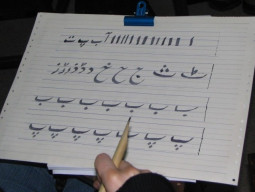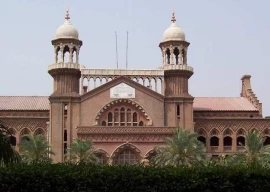
A country deeply divided on ethno-linguistic lines, Pakistan is in dire need to reconsider its policies towards language if it hopes to survive and thrive as a unified national entity. Currently, Pakistan is a country that does not have any ‘Pakistani’-speaking people; instead, it is a country where people see themselves and others as Balochi-speaking, Hindko-speaking, Punjabi-speaking, Pashto-speaking, Sindhi-speaking, Seraiki-speaking and Urdu-speaking, etc. Our ethnic languages separate us. And while Urdu, as a national language, is used in most parts of the county, the idea that it has been successful in uniting us as a nation is a controversial one. To create a unified national identity, we need a language that brings us all together.
Linguistic battle: SLA to fight for Sindhi’s official, educational use

One way of doing this might be by creating a new language — ‘Pakistani’. This new language will draw on the already established languages in the country and integrate features from all other languages currently used in Pakistan (including English). Thus, while it will be a new language in how it integrates features of all Pakistani languages into one and how it is used for various purposes, it will be built on languages that Pakistanis already use and are familiar with. In this way, it will be representative of all Pakistanis.
Creating and developing languages (or aspects of languages) for national unity and/or national development is not a new thing. China, Indonesia, Japan, Malaysia and Turkey, among other countries, have all engaged in considerable language development and planning work in recent times to help with national development. Filipino, the national language of the Philippines, for example, was only created after a policy decision in the early 1970s. The Philippines, like Pakistan, is a post-colonial, multilingual, developing country where people have a strong sense of attachment to their languages. By replacing Tagalog with a newly created Filipino language, which integrated features from local languages, the government was able to get past a number of stumbling blocks and accusations of privileging people from a particular ethnicity/region. Although there are some issues and controversies in relation to Filipino, these are being addressed as the language develops; Article XIV of their 1987 Constitution states that “as Filipino evolves, it shall be further developed and enriched on the basis of existing Philippine and other languages”. In addition, while Filipino is being strengthened, the Philippines government recognises all indigenous languages and has laws in place to promote these through their use in education (through what is known as mother-tongue-based multilingual education, MTB-MLE).
Promoting Urdu: Urdu literati off to Istanbul University
The Philippines provide one of many examples that the Pakistani government can learn from. Language policy and planning can play an instrumental role in creating national unity and aiding national development. Urdu was selected to fulfill this role at the time of the creation of Pakistan. However, it unfortunately has not been very successful in doing so. The Urdu-Bengali controversy, while not the main cause of the separation of East Pakistan, played an important symbolic role in the creation of Bangladesh. Even today, there are groups and communities in Pakistan that choose not to use Urdu. This reflects a failure of successive governments to build a national identity through and around Urdu. Court orders on language use, while symbolic, are not sufficient to deal with the underlying linguistic issues that the country faces.
While we can lament and criticise people and groups for not accepting Urdu, such rhetoric does not help resolve the issues. Given the sensitivities and politics around language, governments prefer not to deal with language-related issues. However, instead of brushing aside or ignoring these issues, the government needs to tackle them head on by developing a well-researched and appropriately resourced language policy. Developing a well-thought out national language policy may reduce a number of current language-based sensitivities, divisions, politics and issues. In addition to decreasing ethno-linguistic conflicts, a good language policy can also have numerous economic, educational, health, legal, social, and other benefits. It is beyond the scope of this article to discuss all of these here, but readers may be interested in looking at the Lahore Declaration on Language Sciences and the Developing World (https://www.academia.edu/2491683/Language_Sciences_and_the_Developing_World).
It needs to be noted that the recommendation to create a new language here is contrary to current proposals presented by some other Pakistani linguists who recommend the dividing up of provinces based along linguistic lines (creating a Seraiki-speaking province, for example). Such recommendations, while appearing to be responding to current sentiments and attitudes, are arguably ones that will take us further down the road of disintegration and disunity. Instead of building unity, such recommendations endorse and strengthen ethno-linguistic divides. If we create language-based provinces for the larger regional languages today, we will have smaller regional language-based groups asking for greater autonomy tomorrow. If new provinces need to be created, then we need strong administrative reasons for this, not linguistic.
Official language: Can’t switch overnight, says Saad
The recommendation made in this article, the need to create ‘Pakistani’, is an approach that aims to unify the people and to allay language-based misgivings and mistrust. This is because ‘Pakistani’ will draw on and reflect the linguistic practices and behaviours of the diverse peoples of the country; it will belong to all Pakistanis and not a particular group. As a ‘new’ language, it will not be a mother tongue of any existing group and everyone will need to learn it in schools and colleges. As a ‘modern’ language, it will be flexible and encourage variations that reflect the needs, desires, customs and habits of the Pakistani people. As a ‘Pakistani’ language, it will be used in education and exist alongside, draw on, and support the indigenous languages of local communities.
The creation, adoption, use, and development of ‘Pakistani’ is not going to be an easy task, but it is an achievable one. There are many examples from around the world that we can learn and draw from in doing so. The linguistics needed to achieve these goals is already available. What is needed now is political vision and commitment to make this happen.
Published in The Express Tribune, November 6th, 2015.
Like Opinion & Editorial on Facebook, follow @ETOpEd on Twitter to receive all updates on all our daily pieces.























1713421519-0/BeFunky-collage-(4)1713421519-0-270x192.webp)






















COMMENTS (26)
Comments are moderated and generally will be posted if they are on-topic and not abusive.
For more information, please see our Comments FAQ